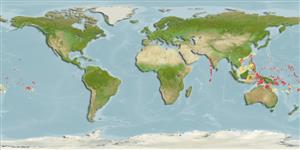Aidanosagitta oceania (Grey, 1930)
Arrow worm| Native range | All suitable habitat | Point map | Year 2050 |

|
| This map was computer-generated and has not yet been reviewed. |
| Aidanosagitta oceania AquaMaps Data sources: GBIF OBIS |
Google image |
No photo available for this species.
Classification / Names Common names | Synonyms | CoL | ITIS | WoRMS
Sagittoidea | Aphragmophora | Sagittidae
Environment: milieu / climate zone / depth range / distribution range Ecology
Pelagic; brackish; depth range 74 - 150 m (Ref. 97338). Tropical; 35°N - 8°S, 130°E - 156°E
Distribution Countries | FAO areas | Ecosystems | Occurrences | Introductions
Pacific Ocean.
Length at first maturity / Size / Weight / Age
Maturity: Lm 0.6 range ? - ? cm Max length : 0.8 cm BL male/unsexed; (Ref. 3682); common length : 0.5 cm TL male/unsexed; (Ref. 97339)
Short description Morphology
Life cycle and mating behavior Maturity | Reproduction | Spawning | Eggs | Fecundity | Larvae
Main reference
References | Coordinator | Collaborators
Pierrot-Bultz, A. 2004 Chaetognatha of the world: Sagita oceanica. Zoological Museum, University of Amsterdam. http://species-identification.org/species.php?species_group=chaetognatha&selected=beschrijving&menuentry=soorten&id=98 [Accessed 27/11/14]. (Ref. 3682)
IUCN Red List Status
(Ref. 130435: Version 2025-1)
CITES status (Ref. 108899)
CMS (Ref. 116361)
Threat to humans
Human uses
| FishSource |
Tools
More information
Max. ages / sizes
Length-weight rel.
Length-length rel.
Length-frequencies
Mass conversion
Abundance
Internet sources
BHL | BOLD Systems | CISTI | DiscoverLife | FAO(Publication : search) | Fishipedia | GenBank (genome, nucleotide) | GloBI | Gomexsi | Google Books | Google Scholar | Google | PubMed | Tree of Life | Wikipedia (Go, Search) | Zoological Record


